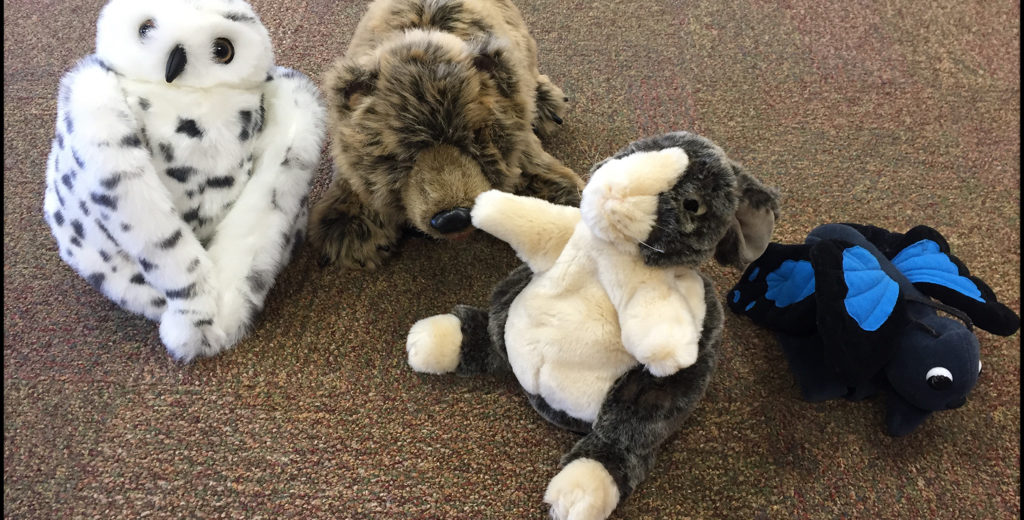
Puppet Pals: Learning the Four Voices
Teaching the four voices (speaking, shouting, singing, and whisper voices) to my Kinders and 1st graders is something I’ve been doing for years. The four “vocal timbres” are in almost every district curriculum I’ve seen and every textbook I’ve ever looked at. “Why do we teach this concept?” you ask. I’m pretty sure that I asked just that when I first started teaching. I mean, shouldn’t they know this stuff already?
Well, maybe students SHOULD know how to differentiate between these four voices, but honestly many can’t. Or maybe they’ve just never been asked to think critically about their voice choice or never been asked to distinguish between the different timbres. Many times I find that students CAN distinguish between their “four voices” but they can’t always decide which is appropriate in a certain setting. For instance: the lunchroom. Which voice is most appropriate? As a teacher, I would say speaking voice or whisper voice… but lo and behold, when 11:30 rolls around, which voice do I head the most of in the lunch room? You guessed it, the shouting voice. So, we take some time and teach the different voices in the hopes that we can train their ears (to hear the differences), their brains (to know which is appropriate and when), and their habits.
I think the voice that we spend the most time working on and developing with children is their singing voice. I can tell you that working with a high ELL (English Language Learner) population, that teaching singing voice and getting students to use it correctly over and over again was the biggest challenge I faced. Shoot, for ELLs it’s hard enough to use their speaking voice with confidence. They want most of all to “not mess up” while speaking in a non-native tongue. For ELL students, singing voice just adds to that struggle. And not just for ELLs, for all students singing voice is weird at first because they are not always accustomed to using their voice in that way or in that register. We work on “head voice” and lyrical quality and we try to teach them to match pitch and sing correct intervals. “Singing voice” is the voice we focus the most on in their formal training in elementary and that teaching goes on for yeas. But it all starts with students being able to identify each voice and know how to use their voices appropriately.
Four Voices = Four Puppet Pals
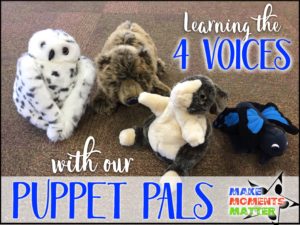 So, how to teach these concepts in a way that is accessible, fun, and non-threatening even for those English Language Learners? I turned to puppets, and I’ll never go back! I’ll admit that in the last year or so, I’ve maybe started stocking up on amazing Folkmanis brand puppets in all shapes and sizes. Folkmanis puppets are super detailed and soft and have fun little tricks and attributes that make each one special. What’s even better is that these puppets are super well made, something you don’t always find when looking for puppets to buy.
So, how to teach these concepts in a way that is accessible, fun, and non-threatening even for those English Language Learners? I turned to puppets, and I’ll never go back! I’ll admit that in the last year or so, I’ve maybe started stocking up on amazing Folkmanis brand puppets in all shapes and sizes. Folkmanis puppets are super detailed and soft and have fun little tricks and attributes that make each one special. What’s even better is that these puppets are super well made, something you don’t always find when looking for puppets to buy.
You can buy the puppets from the Folkmanis website (Folkmanis.com) or you can often find some really great deals from sellers on Amazon. And for the record, I am not getting any sort of discount or endorsement credit from the Folkmanis company for blogging about their amazing puppets. Now, if someone from the Folkmanis corporation reads this blog and wants to give me a promotional credit or freebie or something… well, I wouldn’t turn away the amazing porcupine hand puppet… just sayin’. Anyway, I have a ton of these puppets and I love using them in singing games and lessons where I teach new songs and concepts. The kids LOVE the puppets and think it’s so fun when “a new friend” comes out to teach us something. I use the big fluffy cat to teach the song “Naughty Kitty Cat” and I use the little Robin finger puppet when I teach Lynn Kleiner’s song “Who’s that Hatching.” There are an infinite number of uses for these little guys.
When it came time to teach the four voices this year, I decided to pull out the puppets once again to see if they would catch the kids attention and keep them interested. It worked out beautifully and has been so much fun! A new puppet pal would come out for every new day so that students interacted with one puppet and one voice per lesson. Here’s how I introduced them.
Speaking Voice: Peter the Rabbit
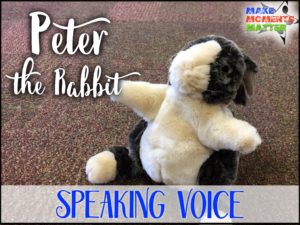
Peter the Rabbit teaches speaking voice.
Peter the rabbit was the first puppet pal to make his debut with my Kinders. Peter was pretty energetic and excited to be there and he hopped around and told them all about how each and every kid had four voices to use in all sorts of different places. He made sure to mention that his favorite voice was probably the most important. Then he told them all about the speaking voice and where he uses it and how he uses his speaking voice.
Sidenote: I named the rabbit puppet “Peter” because I have so many puppets that if I named him something more interesting like “Jack” or “Allegro” or something else I would absolutely forget it by the next class period. “Peter Rabbit” I will never ever forget. Maybe not as creative as it could be, but definitely a name I will remember so that I don’t have to endure Kinders scolding me “that’s not what you called him last time!”
Peter made sure to show the Kindergarteners his big ears. I interjected to tell them that since Peter had such big ears he heard things really, REALLY well. “If you use your shouting voice around Peter it really hurts his ears. That’s probably why he prefers his speaking voice so much.” Peter agreed with me. We talked a little more and then we let the kids try it out. Peter would say “speaking voice” and then they would repeat in their speaking voices the name, “speaking voice.” He taught them a little rhyme. “Speaking voice is the best, it’s better than all the rest.” They loved it!
As a final activity (and a way for me to learn the names of these new little kiddos) Peter went around and had each kid say their name in their speaking voice. After they said their name, he would say it back in HIS speaking voice. With each kid he made sure to compliment them and thank them with something like “Great job!” or “I love your speaking voice.” They got a big kick out of that. Speaking voice and Peter for the win!Love the puppet that I use for Peter? Grab it on Amazon.com by clicking HERE.
Whisper Voice: Flitter the Butterfly
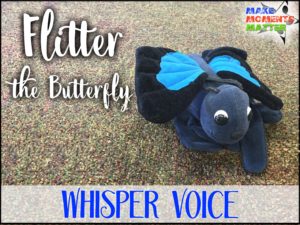
Flitter the Butterfly teaches whisper voice
The next day Peter the Rabbit came back to tell the students about a new friend that he wanted to introduce, but he didn’t tell them what animal the friend was. He made sure to preface that the students have to be very quiet and nice and move slowly around this new friend. “She gets scared really easily,” he told them. They had to be gentle and very quiet.
Then “Flitter” the butterfly carefully flew into the room and sat down on my knee. Immediately the students “got it” and understood why they had to be quiet. I said in my whisper voice that Flitter was a good friend of mine. I always have to be careful around her because butterflies are easily scared. We talked about being outside and how butterflies often fly away when we get close. If we walk slowly towards butterflies and move quietly they don’t get scared away so easily.
Then Flitter introduced herself and talked to the students in a whisper voice. If a kid would respond in their speaking voice I would make Flitter fly away for a second and come back when the students quieted down. They were entranced… Then Flitter told them this little chant, “Whisper voice is the best, it’s better than all the rest.” which they remembered learning with Peter. They thought it was hilarious that Flitter and Peter disagreed.
As a final activity I had Flitter fly around to each kid and each child introduced themselves in their whisper voice. After each kid said their name in their whisper voice, Flitter would repeat their name in her speaking voice. They had fun and after Flitter flew away we talked as a class about how whisper and speaking voice were different.For the record, this is the only puppet in this set of four that is NOT Folkmanis brand. However, should anyone want to send me a better butterfly puppet as a gift, they could absolutely find it at this Amazon.com link and send it to David Row %Woodstock Elementary School, 230 Rope Mill Road, Woodstock, GA 30188
Singing Voice: Snowy the Owl
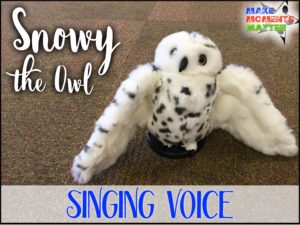
Snowy the Owl teaches singing voice
Peter came back on Day Three to tell us about another friend who wanted to come and visit. Before he went over to call her down from her perch he made sure to remind the boys and girls that “Speaking voice is the best, it’s better than all the rest.” He said that he’d heard maybe Flitter told them something different but that she’s wrong. Clearly speaking voice is the best voice because we use that voice the most. Then he hopped over to get Snowy to come down.Snowy the Owl sits high up in the room on top of my cabinets. She’s been there all year and the students just didn’t notice her until now. Snowy flew down and sang a vocal glide as she came down on a “Whoooooo.” When she would fly up “her” voice would go up and when she flew down her voice would go down. Foreshadowing for vocal exploration later in the year! Finally she found a spot to sit on my knee and she introduced herself to the boys and girls in a lyrical speaking voice. More singing than speaking. She told them about herself and about how she loved to use her singing voice. She mentioned all the places she would sing and how much she loved singing. Then she started to sing “Choo Choo Train,” and “Thumbkin,” both of which we had been learning as a class. The class loved that she was singing their songs.
Then she said that the students would be able to sing too! She taught them this little rhyme “Singing voice is the best, it’s better than all the rest!” on a Sol-Mi interval. They laughed because they were definitely familiar with that phrase by now. They sang it with her and then she told them that she had something special for each student to do.
Snowy would congratulation the kiddos no matter if they used their singing voices or speaking voices in response. Last year I went to a workshop with Lynn Kleiner (an awesome Orffy educator who has tons of experience with Pre-K and early learners) and she suggested that when we first do singing/speaking voice activities we shouldn’t congratulate ONLY the singers. Often at this point there are kids who respond with their speaking voice instead of their singing voice. It is our natural tendency as teachers to congratulate only the singers with “Good job” and to stop and respond to the speaking voice kids with “try again a little higher” or “use your singing voice instead of your speaking voice.” Lynn encouraged us at the workshop to be okay with their response no matter what. They’re still just learning. Give them time and give them lots of examples of the difference between singing and speaking. When we stop only for the speaking voice kids/ask them to do it again the “right way,” we call them out in front of their peers.
Lynn suggested in situations like this one with Snowy that if a kid responds in singing voice that we should sing back their example and if they respond in speaking voice to speak back their response. This gives them an example of someone else mimicking them. It allows them an extra chance to HEAR what they’re actually doing and a chance to start to differentiate between the sounds. I thought that was a really interesting point. This year I’m going to give my little learners time and only ask them to “do it again” once they’ve had lots of chances to get it right.And if you love this really cool snowy owl puppet you can get it at this Amazon.com link. This one is super cool because her wings can velcro shut if you want them to AND there is a little handle inside so that you can make her head spin. It’s super awesome!
Shouting Voice: Grizzly the Bear
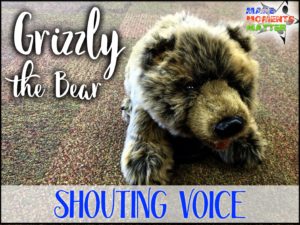
Grizzly the Bear teaches shouting voice
Our final visitor on Day Four was Grizzly the Bear. Peter showed up first to introduce another new friend but when I reminded him who was coming (I whispered in his ear) he decided he wanted to get out of there. He said that this new friend uses a voice that hurts his ears too much! So, when Grizzly showed up I used a really gruff voice that’s a loud speaking voice. Grizzly talks with the kids a bit and tells them that he has a favorite voice too. “This is a very loud voice. It’s the voice you use outside on the playground or out at the park. You don’t really get to use it at school much even though it’s a REALLY GREAT VOICE!”At the ends of sentences Grizzly starts to get louder and louder, switching from a speaking to a shouting voice. I interject as the teacher and remind him that he needs to stay calm inside the school building. The kids love this. Grizzly apologizes and tells me that he’s just really excited and loves using his favorite voice.
I suggest that Grizzly tell us the name of his favorite voice, but “please be sure to use your speaking voice. We don’t want to get too loud!” Grizzly is happy to oblige. So he says, “Well, my favorite voice is a very loud voice. It’s… YOUR…. ” and then I break in and remind him that he’s getting too loud and I remind him not to actually us the loud voice. “Just tell us the name of your favorite voice with your speaking voice.” He apologizes again and starts to try again. “Remember, it’s a really REALLY loud voice. A voice you use outside or in an emergency. It’s…. YOUR… SHOU” and I cut him off again. “No, no, Grizzly! Stay calm. Not so loud.” The third and final time he starts very slowly and calm. “Sorry, sorry, sorry. I’ll really try and control myself…. This is my favorite voice. It’s a very loud voice. It’s…. Your…. (big pause)…. SHOOOOOOOOUTING VOOOOOOICE!!!!!!!” And of course the kids laugh and I try and calm Grizzly/the kids back down.
I tell them that we’re not going to say everyone’s names in our shouting voice. Instead I tell them that they can shout “shouting voice” with Grizzly one time. He says, “well if we only get to say it once, we’d better make it good!” And they shout and have a ton of fun. With selected classes Grizzly will tell them the poem “Shouting voice is the best, it’s better than all the rest. Of course they love that!
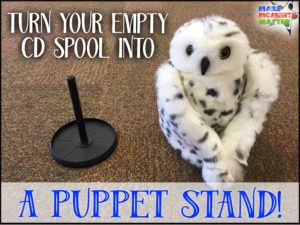
An empty CD Spool works great as a puppet stand!
The puppets make this series of lessons TONS of fun and keep the kids engaged and interested. They keep asking when our puppet friends will come back. My plan is that the four friends will come back later for a lesson recap (if needed) and they will also come out to help teach new songs and poems.One little trick that I came up with was to keep the inside of CD spools and use those as puppet stands. They’re pretty lightweight plastic but the wide base keeps them upright with most puppets. Unless you have a super top-heavy puppet, you should be fine using the CD spool center as a support. I love using these because they’re FREE any time you buy a CD spool and they’re also easy to get. Don’t have any plans to buy blank CDs or DVDs in the future? Send out an email to your school staff and see if anyone has old spools they don’t need anymore. You can also send a request (maybe attach a picture as an example) in a school newsletter and have parents bring in what you need.
Have a fun way to introduce the four voices or maybe an idea to extend this lesson? Leave a comment here or on Facebook! I’d love to hear what you think.






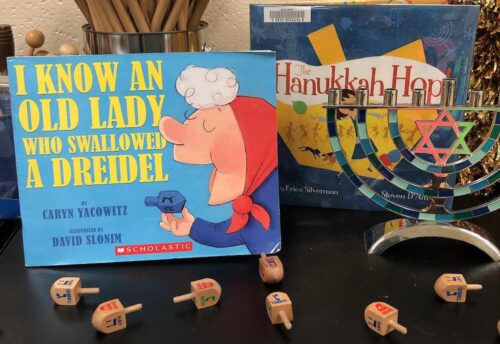
Pingback: 11 Genius Puppet Music Activities for Elementary School Students - Carpe Diem Music EDU
Pingback: Teaching Voices in Elementary Music (and Why Not 4 Voices!) -
Pingback: 5 Easy Ways to Practice the Four Voices (or Five!) in Elementary Music - From Do-Re-Mi To You